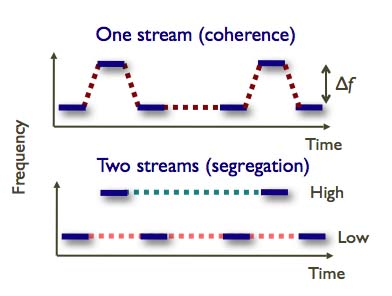


What is happening in your brain when your listening mode is switched?
Makio Kashino- kashino@avg.brl.ntt.co.jp
Suppose you are listening to a piece of music played by several instruments. You could follow a beautiful melody played by an instrument while paying little attention to the accompaniment, or appreciate perfect harmony created by all the instruments. Exactly the same acoustic signal can be perceived quite differently depending on your listening mode, which can be changed voluntarily or involuntarily. What is happening in your brain when your listening mode is switched?
To answer this question, we used rather a simple auditory stimulus to induce the spontaneous switching of percepts, namely, a repeated triplet of low-high-low tones, which can be perceived either as a single coherent stream having a galloping rhythm or two distinct streams of low and high tones (Sound demonstration: Repeated triplets (Low: 891 Hz, High: 1122 Hz (∆f = 1/3 octave), 60 s). While prolonged passive listening, the two types of percepts alternate frequently and randomly. When the frequency difference ( ∆f ) between low and high tones is small, the duration of “one stream” percept is relatively longer than that of “two streams” percept. With large ∆fs, on the other hand, “two streams” percept is longer. Thus we can manipulate the perceptual dominance by ( ∆f ).
We asked participants to listen to the repeated triplets for 90 s, and to report whenever their percept changed from “one stream” to “two streams” or in the opposite direction by pressing a corresponding button, and measured their brain activity using functional magnetic resonance imaging ( fMRI ) . The dissociation between constant physical stimulation and fluctuating perceptual experience enables us to identify brain activities correlated with the perceptual switching per se, separating from brain activities caused simply by the auditory stimulation. An event-related analysis revealed that the auditory cortex and thalamus were activated at the timing of perceptual switching. (The thalamus lies at the center of the brain, and relays auditory information processed at the brainstem nuclei to the auditory cortex). Recent studies have found the neural correlates of auditory stream segregation in the auditory and suprasensory cortices, but none of them has demonstrated subcortical correlates. The present finding reveals not only one of the important functions of the thalamus, but also argues against the conventional view that percepts are formed by the cortical processing.
The results also demonstrated clear temporal asymmetry of brain activities related to the perceptual dominance. The response onset of the activity in the auditory cortex was earlier than that in the thalamus for the transition from dominant to non-dominant percepts, and later for the transition from non-dominant to dominant percepts. Apparently, top-down processing leads to “collapse” a dominant percept and to find a new, less dominant percept. This may be of great biological value in everyday situations, especially when the sensory input is very noisy and the most appropriate interpretation of the input is not obvious.
In summary, the functional imaging experiments suggest that the bidirectional interaction of the auditory cortex and thalamus plays a crucial role for the spontaneous switching of perceptual interpretations for a physically constant auditory pattern.

Fig.1: Schematic representation of the auditory stimulus used in the experiment and two possible percepts for the stimulus.